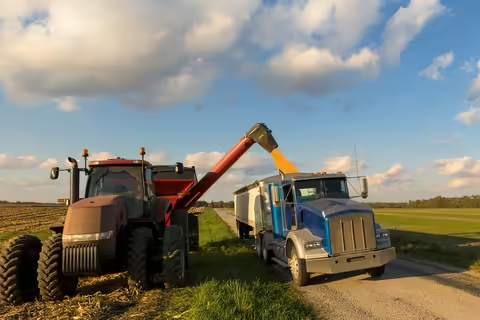DECATUR, Ill. – Harvest season is here and with it comes safety issues on rural roads. Whether you are operating farm machinery or a motor vehicle, please adopt a “safety first” attitude this time of the year.
During the fall harvest, there are more slow-moving farm equipment on the roadways, creating potentially hazardous traffic jams where motorists in a rush least expect them.
"Since many drivers are unfamiliar with the size and maneuverability of farm equipment, operators should use hazards and turn signals diligently. Avoid moving equipment during peak traffic times. For example, shuffle equipment in the middle day to avoid people driving to and from work and school. When yielding to oncoming traffic, slow down and be aware of soft shoulders. Avoid distractions, such as using cell phones when driving, and refrain from carrying passengers. Transportation incidents, including tractor overturns, are the leading cause of death for farmworkers, according to the Center for Disease Control and Prevention," said Josie Rudolphi, University of Illinois Extension associate research scientist.
“A fully loaded tractor, combine or truck moves much slower than the average car or truck,” said Doug Gucker, Extension Educator for Local Food Systems and Small Farms. A car going 55 mph takes 5 seconds to brake 300 feet – that's the length of a football field – to avoid rear-ending farm equipment traveling 15 mph.
• Slow down when approaching farming equipment
• Give yourself plenty of space and be prepared to stop
• Assume the driver of the farm equipment may not see you
• Before attempting to pass, make sure the farmer is not preparing to turn
Drivers should not assume that the person operating the farm equipment knows a vehicle is nearby – they cannot see drivers that are following closely or if they are travelling close to the side of the equipment. Modern farm equipment is often wider than a traffic lane, particularly on bridges and raised roadways. Approaching traffic needs to be prepared to allow wide equipment to pass.
Farmers will pull off the road to allow motorists to pass when it is safe for them to do so, but they cannot move aside immediately since it can be a hazardous maneuver. While most motorists rarely think about them, the condition of the unpaved shoulder is something farmers are very aware of. Shoulders can be soft, wet, rutted or steep, which can cause farm vehicles to tip over.
Watch for the Slow-Moving Vehicle, SMV, sign – a bright orange triangle trimmed with red reflective tape. The SMV emblem is a warning to motorists that the vehicle they are approaching is only capable of moving up to 25 mph, and poses a hazard. The emblem is required by law on all "implements of husbandry," including tractors, combines and other farm equipment.
The law requires farmers to have SMV signs on all farm equipment. Flashing lights or rotating beacons do not fulfill SMV emblem requirements. Remember to clean the dirt off SMV signs, flashers and reflective tape to insure maximum visibility and replace faded SMV emblems and reflective material on outer edges of implements. Add extra reflective tape to increase visibility. Try to avoid heavy traffic times and bad weather for your safety and the safety of others sharing the road with you.
The Local Food Systems and Small Farms program is a branch of University of Illinois Extension that provides research-based information about agriculture health and safety, environmentally and economically sound pest control and improving profitability and sustainability. Follow educator Doug Gucker on Twitter @SoilWaterDoug.
University of Illinois Extension is the flagship outreach effort of the University of Illinois at Urbana-Champaign, offering educational programs to residents of all of Illinois' 102 counties and far beyond. Extension provides practical education you can trust to help people, businesses, and communities solve problems, develop skills and build a better future. Extension offers educational programs in energy and environmental stewardship, food safety and security, economic development and workforce preparedness, family health, financial security and wellness and youth development.
Find us on Facebook or Twitter @uie_DMP.
30 Second PSA – This fall harvest, use a “safety first” approach when driving around slow-moving farm equipment on rural roads. Slow down when approaching farming equipment, especially those with a bright orange slow-moving vehicle sign. Give yourself plenty of space and be prepared to stop. Assume the driver of the farm equipment does not see you. Before attempting to pass, make sure the farmer is not preparing to turn. Approaching traffic needs to be prepared to allow wide equipment, often wider than a single lane of traffic, to pass.
SOURCES: Doug Gucker, Local Food Systems and Small Farms Educator, Illinois Extension
WRITER: Emily Steele, Media Communications Coordinator, Illinois Extension
ABOUT EXTENSION: Illinois Extension leads public outreach for University of Illinois by translating research into action plans that allow Illinois families, businesses, and community leaders to solve problems, make informed decisions, and adapt to changes and opportunities.
